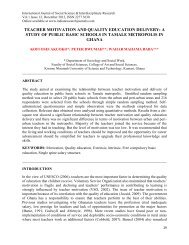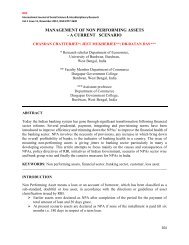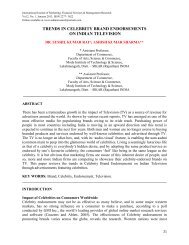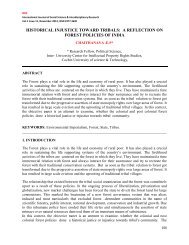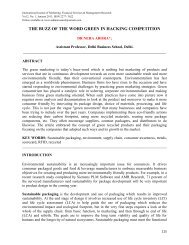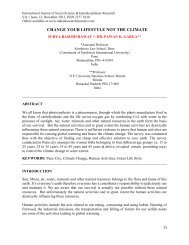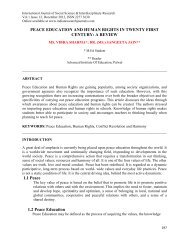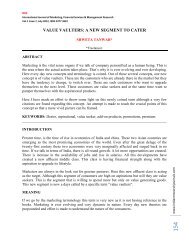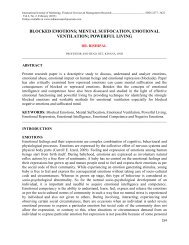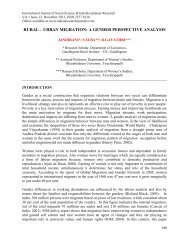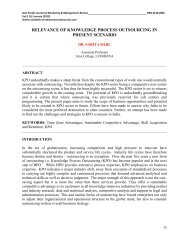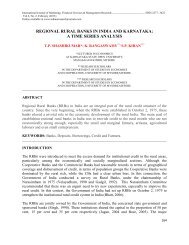problems and prospects of small scale industrial units
problems and prospects of small scale industrial units
problems and prospects of small scale industrial units
You also want an ePaper? Increase the reach of your titles
YUMPU automatically turns print PDFs into web optimized ePapers that Google loves.
IRJC<br />
Asia Pacific Journal <strong>of</strong> Marketing & Management Review<br />
Vol.1 No. 2, October 2012, ISSN 2319-2836<br />
by research organization/agencies are utilized to large extent. In addition to this, business tours<br />
<strong>and</strong> market surveys are other sources which are taken into consideration frequently. It is brought<br />
out on the basis <strong>of</strong> t-values that there is significant difference in practices <strong>of</strong> utilizing the<br />
different sources <strong>of</strong> information both by exporting non-exporting <strong>units</strong>.<br />
MAIN FINDINGS<br />
Here we shall put together some <strong>of</strong> the important points emerging from analysis<br />
undertaken in the preceding chapters. Although the findings are based on data collected from<br />
sample <strong>units</strong> located in Haryana, but these highly represent the <strong>small</strong> <strong>scale</strong> <strong>units</strong> as a whole. For<br />
location <strong>and</strong> other considerations, Haryana is in fact the most ideal State for a study <strong>of</strong> this kind.<br />
It has been found that sole proprietorship is the most dominant form <strong>of</strong><br />
ownership/organization in exporting <strong>and</strong> non-exporting <strong>small</strong> <strong>scale</strong> <strong>units</strong>. But, in non- exporting<br />
SSI sector it is more prevalent. At second place partnership form <strong>of</strong> organization is popular. In<br />
the exporting <strong>and</strong> non-exporting both have their maximum <strong>units</strong> in this form <strong>of</strong> organization.<br />
While, joint stock companies is less popular forms <strong>of</strong> organization in both exporting <strong>and</strong> nonexporting<br />
<strong>units</strong>. Maximum exporting <strong>units</strong> are in partnership form.<br />
Majority <strong>of</strong> <strong>units</strong> (65percent) belonging to non-exporting are young (six to ten years) in<br />
age. In general a positive relationship is seen between age <strong>of</strong> the firm <strong>and</strong> their asset size. While<br />
exporting <strong>units</strong>, on the other h<strong>and</strong>, consists <strong>of</strong> a large proportion <strong>of</strong> <strong>units</strong> which are older (more<br />
than 10 years in age) as compared to non-exporting <strong>units</strong>.<br />
On an average, each unit <strong>of</strong>fers employment to 19 persons. The capital invested per<br />
person indicates the <strong>units</strong> with less investment <strong>of</strong>fer a relatively greater employment potential<br />
than that <strong>of</strong> employment <strong>of</strong>fered by higher investment <strong>units</strong>, because machinery replace the<br />
human being. So, more investment decreases the opportunity <strong>of</strong> employment.<br />
Here, two types <strong>of</strong> <strong>small</strong> <strong>scale</strong> exporter, merchant exporter <strong>and</strong> manufacturer exporter are<br />
taken into consideration. Responses show that maximum (75%) <strong>small</strong> <strong>scale</strong> <strong>industrial</strong> exporting<br />
<strong>units</strong> doing both activities (i.e. merchanting <strong>and</strong> manufacturing) for their product. In addition to<br />
this, percentage <strong>of</strong> manufacture exporter is 11.67 per cent <strong>and</strong> merchant exporter is 13.33 per<br />
cent in <strong>small</strong> <strong>scale</strong> exporting <strong>units</strong>.<br />
Interpretation <strong>of</strong> Problems faced by SSI <strong>units</strong> show that Finance problem is largely faced<br />
by non-exporting <strong>units</strong> while exporting <strong>units</strong> have to face the <strong>problems</strong> like executive<br />
inefficiency, technological lag, <strong>problems</strong> relating to export etc. In addition to this, terms <strong>of</strong><br />
payment is also a major problem which is equally faced by both exporting <strong>and</strong> non-exporting<br />
<strong>units</strong>.<br />
It has been further, observed that the SSI <strong>units</strong> are carrying their business to fulfill the<br />
various objectives. The observation <strong>of</strong> these objectives in term <strong>of</strong> priorities indicates that there<br />
are various objectives such as sales growth, maintain existing share in market, higher market<br />
share <strong>and</strong> targeted return. It is observed that exporting <strong>units</strong> highly preferred higher market share<br />
205<br />
www.indianresearchjournals.com



